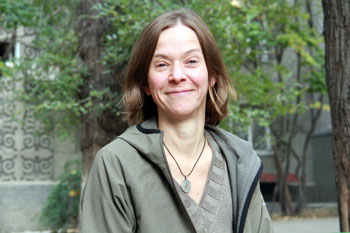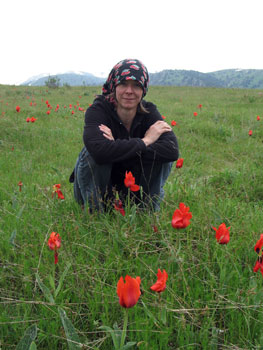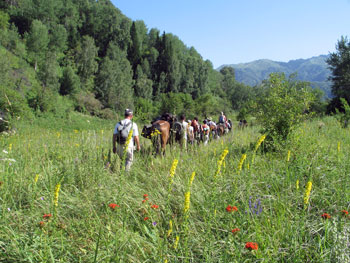ASTANA – Dagmar Schreiber, a native of Germany, arrived in Kazakhstan for the first time in the early 1990s, fell in love with the country at first sight and decided to dedicate the rest of her professional life to it.

Dagmar Schreiber
She has written the unique 568-page volume “Kazakhstan – Nomadic Routes from Caspian to Altai,” which has already become one of the most significant English-language works about Kazakhstan.
Dagmar Schreiber explained the reasons for her move to Kazakhstan and shared her vision for ecotourism development in the country in an exclusive interview with The Astana Times.
When did you come to Kazakhstan for the first time? What was the reason for your move to the country?
My first visit to Kazakhstan was in December 1994 under the World Bank project Living Standard Measurement Survey (LSMS – Kazakhstan). Prior to 2008, I regularly came to Kazakhstan, three to eight times each year, under various projects, at first in sociology, then in market research and consulting, and from 2003 in tourism.
The main reason to move to Kazakhstan was my work at the Kazakhstan Tourist Association (KTA) since 2008 under the agreement on technical cooperation between Kazakhstan and Germany. The Centre of International Migration and Development (CIM) finances my work under this programme.
How did you perceive the country and people of Kazakhstan? What changes have occurred in Kazakhstan since your first visit?
My perception is changing. Not only is the country constantly changing, I am also changing like any other human being, and so is my own point of view. The more actively a person is involved in the life of a society, the more intense his perception becomes.
At first, I perceived the country as incredibly large, boundless and mysterious. However, a strong sense of collapse was literally in everything. I was shocked by the abrupt changes that had taken place in society since I returned to the motherland in 1987, after studying in the Soviet Union. The economy and social life were paralysed. People were losing their skills. Moral norms of Soviet times fell before my eyes. I just felt sorry for the people. At that time, in the general poverty, the polarisation of the society was not so much evident as nowadays, although the foundations were created at that time. However, it was not noticeable for an outsider. I was impressed by the people’s resistance and calmness. Although the life of many people was obviously hard, they were kind and hospitable to foreigners. This impression is still very strong, as if there is a pattern: the more humble a person lives, the more responsive he is in how he treats people… This about Kazakhstan.
Changes in the country? In some places they are very significant, in other places it seems there are almost none. Of course, today life has changed in the major cities. There is a full abundance of the attributes of a modern country – for those who have money. Business travellers who come for a few days and stay at one of the expensive hotels of Almaty or Astana, dine at Farhi or Del Papa restaurants, see chicly dressed young people and these expensive SUVs, say that they are surprised by the wealth of the country. However, if I go by public transport in the neighbourhoods or accompany tourists in the hinterland to the natural gems, it seems to me that there is no positive change or just a little. Most of the people in remote areas are still living in poverty, so they are striving to move to the city. However, here, they have no prospects as well, alas. I am outraged that on the outskirts of large cities there is the growing phenomenon that in the third world is called favelas, with the manifestations of social tension. The fact that the Ministry of Regional Development was formed and that President Nursultan Nazarbayev talks about the need to adjust the excessive social inequality is only logical against this background. The country’s average indicators say little about the true welfare of all its citizens.
What is the main idea and objective of your guide to Kazakhstan?
I just want to share my stunning impressions of Kazakhstan. I want more people to became aware of this amazingly diverse country with beautiful nature and friendly people. It would be nice to develop tourism in the country, and through it to create jobs, exactly in the areas of relatively unspoilt nature. I mean the remote areas from which people are leaving now because of futility.
When and why did you decide to start working as a tourism freelancer?
I decided to start working as a tourism freelancer after I finished the first edition of my book in 2003. At that time, after numerous trips and hikes around the country, I realised that there was something to show, and I was right. In 2003, I had only a dozen tourists, and 200 tourists three years later and more each year. Then I realised it was the perfect combination: to make my hobby – to travel, to communicate, to write – the content of my work.

Dagmar Schreiber on the beautiful spring tulip meadow.
The Ecotourism Information and Resource Centre was established in 2005 on the initiative of the Kazakhstan Tourist Association (KTA). This was a courageous and visionary step. My colleagues had realised before the others that ecotourism is the kind of tourism in Kazakhstan that is the most promising due to natural circumstances and in view of global trends. They have made considerable efforts and gathered resources for the idea to be implemented. International sponsors such as the UNDP [United Nations Development Programme], the VSO and Exxon Mobile rendered assistance at the early stages.
The most important goal is to create a nationwide network of private rural guesthouses in the areas where the natural conditions are ideal for ecotourism – near national parks and other protected areas. This combination of community-based tourism and ecotourism is being implemented successfully around the world.
Placement is a key factor in the development of tourism products. To build hotels in areas of pristine nature is the first step towards its destruction. We do not want it. However, using people’s houses, which exist already, as placements – we can kill two birds with one stone: the tourists have a place to live and the people have an opportunity to earn money. Of course, it will not happen spontaneously, it is necessary to prepare and organise everything; that is, to persuade, to educate owners of houses, to equip these houses for the needs of tourists, to assist in the development of tourism products, to advertise houses and tours and to send tourists there. That is what we are doing now.
In the future, I would like to see a successful system of ecotourism like in Germany and the United States, where the carrier of ecotourism is the National Parks Service with its highly developed system of environmental protection, tourism and educational work.
Could you share your opinion about the development of ecotourism in Kazakhstan?
Kazakhstan has huge natural potential for the development of ecotourism. However, there is still much work to be done in this field.
Ecotourism, if we understand it correctly as responsible tourism in nature, which unites both the interests of campers and the local population and does not destroy either the nature or culture of the region, is still underdeveloped in the country.
Tourists, campers or travellers think only of their own recreation. Many people perceive ecotourism the wrong way. They organise day trips and picnics with fires. Often, their fishing or hunting is illegal. It brings a lot of harm to nature and is most likely the anti-ecotourism. The ecotourism that we want to develop assumes that campers should realise that their children deserve to enjoy the same beautiful, clean and pristine areas, too.
 At the same time, we realise that people, especially when they are on vacation, do not like to be taught. Therefore, we have to create the preconditions of unconstrained, interesting, diverse, but at the same time responsible recreation. It is a question of political will.
At the same time, we realise that people, especially when they are on vacation, do not like to be taught. Therefore, we have to create the preconditions of unconstrained, interesting, diverse, but at the same time responsible recreation. It is a question of political will.
Ecotourism is well developed in Kazakhstan where small and medium-sized businesses with initiative and professionalism have set up projects, often without any government support. Such examples are in Aksu-Zhabagly, Lenger and Kaskasu in the South Kazakhstan region,, where there are private guest houses with interesting tourist offerings; the Trekking Club camp in Turgen gorge in the Almaty region; Pelican base on Alakol; the yurt camp of the Central Asia Birding Company; the offerings of Zhibek Zholy and Asia Discovery tourist companies in the Almaty region; Nomadic and Zere Tour travel agencies in the Karaganda and Aktobe regions; in the Akmola region, guest houses in Korgalzhyn and the Druzhba cultural and tourist complex in Balkashino; in the East Kazakhstan region with the Altai Expeditions firm with interesting tours and elsewhere.
Recently we discussed a proposal to carry out an experiment: to encourage hunting farms that are working in strict accordance with the legislation and quotas, to help them to expand the season; that is, to send ecotourists to the hunting houses in spring and summer so that they could increase the number of tourists and offer rangers work as tour guides. That is, we are slowly expanding the range of ecotourism activities.
What is necessary for Kazakhstan to increase the number of ecotourists coming here?
First of all is to change the attitude of many of its citizens to nature. I have recently returned from a botanical tour around the Almaty and East Kazakhstan region. We were in very remote areas to find rare plants that are not available in Europe, especially wild tulips and other bulbous plants. We found them all. At the same time, we found tons of garbage in the most remote areas. It is sad. Walking in nature, the soul sings of these spacious landscapes, the spring bloom and the singing of birds – and suddenly you are facing a mountain of cans and bottles, partially broken, plastic bags, paper. People ride their SUVs unceremoniously on untouched meadows, even in the national parks. They throw large bouquets of Red Book plants, wash cars in pristine mountain rivers, probably; they just do not know that the engine oil is killing all the fish downstream. They burn the steppe when thousands of birds are nesting in the grass and bushes, cut down trees, although less than one percent of the country’s area is covered by forest.
If we want people to love and respect nature and ecotourism to become a normal phenomenon, we must eradicate the apathy and consumerist attitude that most people have about nature. Environmental education begins in childhood. For example, I became an ecotourist unwittingly thanks to my parents, who showed me large and small beauties during our walks and hikes, as well as during our numerous school trips and multi-day trips to children’s holiday homes and youth hotels, where very skilful eco-educational work is carried out.
I am convinced that the number of foreign ecotourists will increase if it is seen around the whole country that the nature is respected and considered as a major, renewable resource for tourism.
Are you developing any ecotourism projects in Kazakhstan now?
Yes, we would like to expand the chain of guesthouses in promising areas such as Mangystau and the Almaty region. We would like to contribute to the improvement of the national parks and to make them real centres of ecotourism. We would like to develop various tour programmes with our partners in the regions, and then create an interactive site for booking trips to rural guesthouse as a package with these tours. This project has been very successful for many years in Belarus.
At present, we cannot implement it because of the lack of human and financial resources. Nevertheless, we hope all of our plans will be implemented. Our centre has been functioning since 2005, and since then has been working exclusively thanks to sponsorship money, small funds from KTA and the enthusiasm of staff and partners in the regions. Some support was given by the Akmola and Almaty oblast administrations.
The projects we want to implement require public support, and not just in financial terms. The projects need legal, administrative and structural frameworks, environmental education and upbringing.
What problems exist today for Kazakhstan’s image as a tourist destination?
If your newspaper came out as a multi-volume edition, it would be possible to recount all of them… Fewer words, more deeds. The image cannot be better than the real situation. If domestic tourism and nature conservation in Kazakhstan receive another rating, if the infrastructure and services for its own population are at the proper level, if the prices are close to the level of service or the service rises to the level of prices, if the fight against corruption is successful, then the country’s image as a tourist destination will improve. In this case, solving visa and other administrative issues will remain a mere formality.
Could you share your opinion on what Kazakhstan can offer European tourists? What places are of great interest to Europeans in Kazakhstan?
Let’s try to start from the demand that already exists in the country today. Europeans are coming here because of the places which are not available in their countries. They include the spacious Sary Arka steppes, where you can drive tens and even hundreds of kilometres without seeing either the city or its wires, but instead numerous herds of horses, silver waves of grasses, quaint mountain oases such as Karkaraly, Ulytau, Bayanaul or Kyzylarai, lakes with flamingos and pelicans and hundreds of other bird species and, if you are very lucky, a saiga antelope herd. Dozens of species of wild tulips in the steppes and in the mountains of Karatau, Tien Shan, Dzhungar Alatau and Altai as well as the other wild plants that are cultured in Europe, but here they just grow in nature! Peonies, irises, watersheds, violets, Eremurus, mallow, saxifrage and many things. This year, after heavy winter rainfall, they are growing particularly quickly. My tourists were thrilled! The lunar landscapes of Mangishlak (Mangystau) with their chinks of white and pink limestone, necropoli, which from a distance look like a mirage, with the mysterious underground mosques, where, once, the masters of Sufism lived and taught. The majestic alpine ridges of the Tien Shan, Dzhungar Alatau and Altai where many peaks are still nameless. They are great places for grand hiking or horse trekking-tours, and rafting on the picturesque and abounding mountain rivers. However, now it is very difficult, as the most beautiful routes are not available for foreign tourists since they are located in the hunting grounds or, worse yet, in the border zone, so they first have to solve many administrative issues. If we created a chain of equipped ecological trails and alpine huts here, I am sure the people of Kazakhstan and foreigners would be happy to use them. National parks and reserves such as the Aksu-Zhabagly reserve and Tengiz reserve, Korgalzhyn lakes and national parks such as Karkaraly, Charyn, Altyn Emel and Kolsai. The entire site of the Silk Road in Kazakhstan, numerous ancient towns still awaiting their second opening through excavations, like Koyalyk, Talhiz, Taraz and towns in the Kyzylorda region, as well as the other historical sites of Scythian and Turkic period. Baikonur, if the administrative barriers to visit it are removed. The boomtown, the city of EXPO 2017 – Astana. And the metropolis at the foot of the mountains of Almaty, if the problems of traffic jam and smog in this unique city are solved. Places of power, as in the Altai or Mangishlak, where even without a shaman a person can feel that he or she is receiving nature’s energy.
Places of Soviet heritage such as Karaganda, Zhezkazgan, Balkhash, Semei, the polygon… Health tourism in Alakol and the hot springs is also not hopeless.
Besides these places to see, there are a lot of events and customs that can be developed as tourist highlights: Horse games, music and other cultural festivals, the caravan along the Silk Road, the newly established sports competitions such as steppe cycling rallies and more.
I also want to add that this cannot be implemented without any human factor. All these masterpieces should be presented by professionals who can not only explain these places and events in clear language, but literally shine with the love of their motherland and are able to share their enthusiasm with visitors. We need tourism education and schools for guides and experts now so that we have time before EXPO 2017 to train a sufficient number of qualified professionals.


